ISTQB CTAL-TM Certified Tester Advanced Level Test Management (CTAL-TM) v3.0 Exam Practice Test
Certified Tester Advanced Level Test Management (CTAL-TM) v3.0 Questions and Answers
You are reviewing the project's traceability matrix after the first cycle of testing. You have discovered that new requirements have been introduced and others have
changed.
What should you do? [2]
You just handed over the Defect Accepted and Deferred report to your Maintenance team.
Which testing activity are you performing? [1]
Which three of the following would be considered a good mix of technical and interpersonal skills (hard and soft), for a test team leader?
a. Ability to compliment a developer.
b. Presenting information regarding a test project progress to stakeholders
c. Using a configuration management tool.
d. Ability to read a development coding language
e. Assessing a failure and documenting it correctly.
Which combination matches the four cost of quality categories with a CORRECT example of its category?
You are a Test Manager on a new project. The software that is being created will be used to control the projectors in movie theaters. This is a time critical project because the software must be released before the Christmas holiday season which has the highest movie attendance of the year.
You have decided to implement a review process for the work products that are a part of this release to save both time and money. In order to expedite the training, you brought in a consultant to
train the participants and moderators in proper review processes. Your team is enthusiastic about participating in the reviews.
Your manager is questioning the money you have spent on this training effort. He wants to know how you intend to justify the expense when you present your numbers at the annual budget
meeting in February.
What would be a reasonable way for you to justify the cost of the training and the reviews when you present your information at the budget meeting? [3]
Test Analysts are doing test design for a change request to an insurance comparison system. The system provides car insurance quotations, using data input by the user.
The change request states:-
Drivers must be aged between 17 to 85 years inclusive to qualify for insurance comparison.
The following Test Conditions have been identified:
1 Driver's age is less than the minimum
2. Driver's age is within the valid range
3. Driver's age is more than the maximum
The Test Strategy states the test techniques to be used include Equivalence Partitioning and Boundary Value Analysis. Using the Test Conditions and techniques stated in the Test Strategy, the following Test Cases have been created.
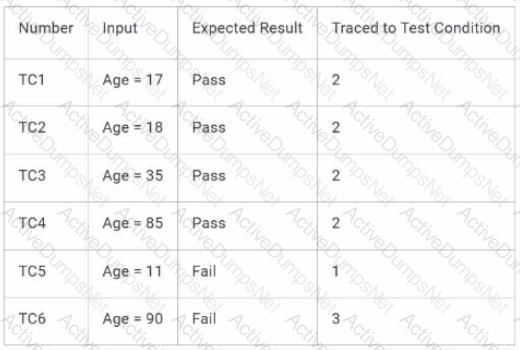
As the Test Manager you are reviewing these Test Cases for traceability to the Test Conditions and to ensure that the change request will be adequately tested in accordance with the Test Strategy.
Which of the following statements is FALSE? SELECT ONE OPTION
Which of the following is likely to occur if reviewers do not have an adequate level of technicalknowledge? [1]
You are Test Manager of a project delivering a workflow system for complex business processes It has been decided a tool is required to increase the efficiency of test execution. What would be a valid issue to consider when deciding whether to build a custom made tool?
SELECT ONE OPTION
Your testing team has just received the test conditions for a new project. You are conducting Test Design activities for this project. Your team feels that it would be beneficial to create high-level test cases.
What should they do concurrently with creating these test cases? [2]
Which work experience is likely to develop the necessary skills to effectively test a software system? [3]
You are the Test Manager of a risk-based testing effort. You develop the following graph to show residual risk. Assume that "Risks mitigated" represents passed tests and "Risks not mitigated"
represents failed tests and other discovered failures.
Which of the following answers best represents what the graph shows? [3]
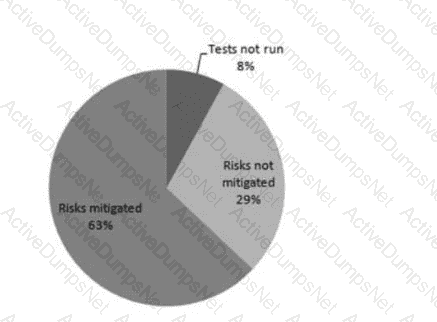
How does a risk based testing approach address risks in a software product? SELECT ONE OPTION
You are managing a project that will be using a model-based testing strategy.
Which of the following is an activity that will be needed in order to implement this strategy? [1]
You are the Test Manager on a new project. The schedule is aggressive and will require the team to work at peak efficiency. The requirements are not well defined yet, but it is clear that the
project will be using new technologies. To help the developers meet the development schedule, an offshore group will be added to the development team.
At this time there is not enough budget to add more testing resources. The project stakeholders are very concerned about the quality of delivered product and will be watching the project closely,
particularly during the testing cycles. The exit criteria from the system test level require no open high priority/severity defects, 100% pass rate for all test cases covering risks that are classified as
"high" or "very high", 90% pass rate for all "medium" risks and 50% pass rate for all "low" and "very low" risks.
Given this information, which lifecycle model should you recommend? [3]
The previous release of an in-house invoicing application was live for 6 months before beingreplaced by a later release.
• Before it went live, €1,500 had been spent on defect prevention and a further €4,500 had been spent on writing and running tests; these tests found 80 defects and the average cost of dealing with these was €50 each.
• By the time that it was replaced, defect reports from live running showed that pre-release testing had found only 80% of the defects that were present; the average cost of dealing with the defects that went live was 12 times that of the internal failures.
Which statement is TRUE?
'Safe as Houses' is a company that specialises in home security software, including alarm systems, surveillance cameras and other forms of deterrence.
It is currently developing the software for a device which simulates an active television, producing sound and light images that suggest someone is home watching the television. 'Safe as Houses' recently won a lucrative contract to supply the software to Smart Alarms', who will be manufacturing the hardware devices Sound will be created using actual television and film archives, licensed through a third-party supplier, 'Silver Sound Ltd'. A user interface will be developed in house to allow the customer to choose sound tracks.
The software will be delivered as a programme of work, consisting of three projects. Project 1 will develop the software for the light images. Project 2 will develop the sound system and Project 3 will integrate the two using hardware prototypes supplied from 'Smart Alarms'. The programme will conclude with 'Smart Alarms' performing User Acceptance testing in usability labs.
The 'Safe as Houses' test team has experience in testing alarm and surveillance systems but lacks experience in testing light imagery software. The organisational test policy includes the following objectives:
1 Exploratory testing should be used to augment more formal, structured testing within constraints of time and budget
2. Test automation tools should be purchased and employed to maximise the breadth and efficiency of regression testing
The Programme risk register currently includes the following risks:
RISK1 Working prototypes will be delivered late to the integration test environments
RISK 2 A delay in signing the contract with 'Silver Sound Ltd' will impact the programme schedule
RISK 3 Inexperience in testing light imagery software will cause major defects to be missed RISK 4 The user interface software for the sound systems will be delivered late into testing
Refer to SCENARIO 2 - The IT Director for 'Safe as Houses' is recruiting a Programme Test Manager and has been provided with a skills matrix for four prospective candidates. The matrix shows the skill level (5 being highest. 1 lowest) for each candidate:
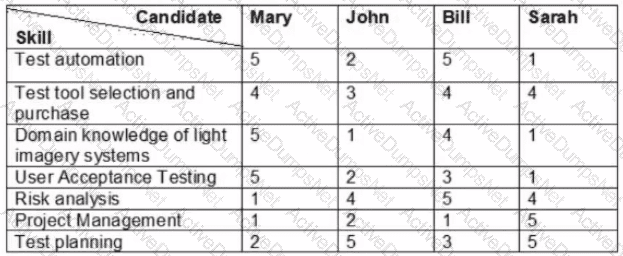
Consider which of these skills are key for a Programme Test manager in this scenario. Based on these, which candidate would be the most suitable?
SELECT ONE OPTION
Which of the following is an advantage of specifying test conditions at a detailed level? [1]
System testing on your current project is coming to an end and it is time to write the test completion report. The product is an in-house development to support the Sales & Marketing department. Test design was based on requirements analysis.
Which of the following metrics is MOST likely to be useful to help the business stakeholders decide if testing has met its objectives?
Which of the followingis a factor that is likely to increase the test estimate? [1]
The diagram shows a defect workflow in which two states do not have appropriate names.
Which option could correctly provide the missing state names?
Which TWO of the following statements are TRUE about a model-based improvement approach?
SCENARIO 1
DreamPartner dating agency are redesigning their dating application following a major security breach in which sensitive customer data was made publically available. The redesign includes stronger security encryption and performance tuning.
The product risk register for the redesign project, which was produced after all requirements had been agreed, includes the following:

The organisational Test Strategy contains the following objectives:
1. A Risk-based lest approach must be adopted for all projects
2. Functional regression testing should start as soon as functional testing is complete
3. Automated tests may be run before or in parallel with manual tests
The project Test Plan has allocated 6 weeks to complete all test execution, with functional testing taking 3 weeks to execute, performance and security testing 2 weeks each and regression testing 1 week.
Which of the following options places the test suites (TS1 to TS5) in the correct order for test execution?
SELECT ONE OPTION
SoftTech provides a core banking product to retail banks to enable their customers to process payments via the Internet and telephone banking and. as SoftTech's Test Manager, you are responsible for system testing and system integration testing of all SoftTech's products.
Your current project is to integrate SoftTech's core banking product with an existing bank's systems, which are maintained by experienced developers but poorly
documented.
A specification for the 10 interfaces to the bank's existing systems has been produced by SoftTech's development team. There is an estimating matrix for system integration testing that allows 2 man days per interface for preparation, plus 2 man days per interface for test execution. The exit criteria for the completion of system integration testing has been agreed as:
1. No open Severity 1 defects
2 No more than 10 open severity 2 and/or 3 defects
3. All interfaces tested
4. Cost estimate must not be exceeded
System integration test execution is scheduled to last 5 weeks, with week 5 reserved for regression and bug fixing only. At the end of week 3 the following test report has been produced (figures on a week by week basis, not cumulative):

B. Open severity 2 and 3 defects
c. Interface testing progress
d. Development resource for debugging
e. Available budget
SELECT ONE OPTION
You have directed one of your testers to construct a "smoke test" to execute against new builds prior to starting formal testing. This is an example of which software development lifecycle activity?
[1]
You are the Test Manager for a software house (SoftTech), who provide a core banking product to retail banks around the world to enable their customers to process payments via the Internet and telephone banking.
Your current project is to integrate SoftTech's core banking product with Welsh Bank's existing bank systems. However, Welsh Bank's systems are maintained by experienced developers and are poorly documented.
Welsh Bank has stated that this project must comply with Financial Conduct Authority (FCA) regulatory banking standards.
A specification for the 10 interfaces to Welsh Bank's existing systems has been produced by SoftTech's development team.
You have been asked to plan and conduct reviews for the system integration and support documentation of all the systems. Which of the following is the BEST approach for this project?
SELECT ONE OPTION
Which of the following statements define a test monitoring activity?
Which classification information would be most useful to capture for newly identified defects? [2]
Which testing metric identifies defect density? [1]
You are a new Test Manager on a maintenance release for an existing mature product that is expected to be retired in the not too distant
future. The previous release had utilized a performance regression test suite written in an in-house custom tool using the same
programming language as the product itself. This suite will most likely require tweaking to ensure it works with the new version of the
product. While there are several members in the performance testing team, the original author of the performance testing tool has moved on
to another company, and none of the remaining staff have a great deal of familiarity with the performance test scripts used to test this
product.
How would you recommend this scenario be addressed? [3]
Your current project is delivering a warehouse management system for use in distribution centres, you are writing a test plan to address acceptance testing. You need to determine which stakeholders would be interested in receiving regular reports covering the progress of test execution against agreed schedule and budget. Which roles would be MOST interested in these reports?
Which of the following metrics is MOST LIKELY to trigger a control directive to increase test execution resources?
Which of the following statements is true regarding Fault Tree Analysis? [1]
Your company is installing a third-party enterprise-wide business software package. This is the first time the company has done anything like this.
Which technique would be the best one to use to estimate the testing effort? [3]
Which is a typical test task that would demonstrate the professional and methodological competence of a tester?
What is the purpose of lest control?
Which of the following Is considered a heavyweight risk-based testing technique'
You have been assigned t o a project that has a very tight schedule. In fact, given your first analysis you do not think the planned test execution can be completed within the schedule There is no time allowed for defect fixing or for repeating tests. Regression testing has been left out of the planning entirely There is no time to develop test automation. The team has agreed that this Is not the way to run a project, yet they are stuck with the current schedule
Given this information what is the best way to proceed with the testing to try to meet the deadline with the best outcome1?
Which of the following Is a way in which risk analysis drives test analysis?
You are working on a project where the business part of the organization works traditionally with defined requirements, but the development team follows an Agile model Neither team plans to change their approach What is the proper name for this type of project approach''
You are managing the testing for a bank card project. The testing was scheduled to take 10 weeks but by the time the software was developed only six weeks were available for testing Knowing there were a lot of risks with the software your team started testing activities early by overseeing code reviews, defining acceptance criteria by working with the users and by doing all lest creation prior to the code arriving
You are now three days away from the go-live date Your testing has mitigated all the high and medium risk items leaving only the low-risk elements unmitigated by testing You estimate it will take two weeks to manually test the low-risk elements At this point what should you do?
Your team has been assigned to a new project You have a mix of manual testers and automation engineers but everyone is currently doing manual testing. The development learn has alreadydecided to use DevOps as its approach but they have never used it before and are happy to take your input Unfortunately, about 50% of the development is completed already In the testing your team is doing they are finding that about 40% of the defects they catch are actually regressions caused by other changes
Given this information what should you do to help mitigate risk'?
If you are monitoring code coverage during testing to determine what areas still need testing what type of testing is likely occurring?
At what testing level do the test management activities Include coordinating with end users7
What is the purpose of the defect management committee?
You are managing the test team that is testing a new mobile application that provides a "step-by-step' hiking guide Your risk assessment resulted in the following table:
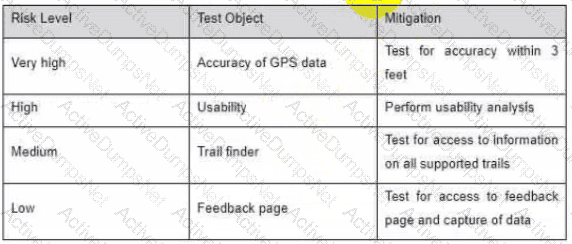
Your team has clone the depth and breadth testing for the GPS accuracy and usability features but when the product was given to beta testers there were some issues Despite the users reporting the app was easy to use at least one user walked off the edge of a cliff and another one ended up in a river. Your team has confirmed that the functionality is working correctly. and the GPS information is accurate.
What other area of testing should you now prioritize?
You are working for an outsource testing company You have a client that will only consider candidates that are highly skilled with Salesforce. regardless of the number of years they have spent testing similar products You have looked through your skills matrix and you have no one with the right type of experience for this project.
What competence area is your team lacking?
You have been seeing a high number of rejections of defect reports The developers are complaining that they do not understand what the problem is. even though they have been supplied with screenshots. You have checked a number of the 'problem' defect reports and have not found any information that is missing. The descriptions are very detailed and include all the necessary information in a long descriptive paragraph.
What change should you recommend that should help with the developer s problems?
Your team has been working on an Agile project for two months. There is a retrospective at the endof each sprint One of the data items reviewed is how many defects are being caught by users rather than by testers. The test team is being blamed for these escapes
What do you need to do to make these sessions more productive?
Your organization has decided to augment your testing team with an offshore team. The offshore team members are experienced testers who are experts in the domain of the system under test Your team is worried about the offshore team taking their jobs and they are resistant to the change You need to pick three of your team members to be the ambassadors for the new team
Which competences will be most important for your ambassadors to possess?
You are looking to Improve the efficiency of testing. The developers have been claiming that the majority of defect reports they receive are invalid either due to the test environment or because the tester did not follow the right steps In a standard defect management process where should you look for more information about these invalid defects?
Your team has been assigned to test a loyalty card program for a supermarket chain. Because this is a highly competitive market significant investment has been made to determine the shortcomings of the products offered by competitors While the feature sets are mostly the same, there is a wide variance In usability and performance and the users perceptions of these quality characteristics
Given only this information what test approach would be most appropriate?
Your manager has decided that your team of manual testers should all become test automation engineers Your team is much stronger in analysis than In technical testing so you are concerned about their ability to adapt. What tool capabilities could help with this transition?
You have assembled the following cost of quality numbers 200 defects were found prior to release and 100 were found after.
Given this information what is the total cost of quality for this project?
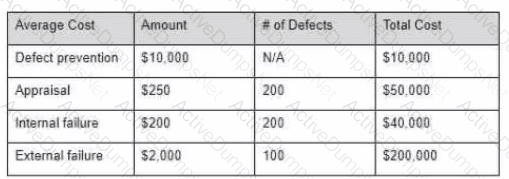
Which test process improvement model consists of five maturity levels?
One of your team members is struggling to identify the requirements to be tested for a project The requirements documents are not conventional but you have determined that the data is there. If they do some digging to find it Given this information in what competence area does this person need to improve?
Your team has decided that they will build their own test management tool This will allow them to link the requirements and test cases together providing full traceability It will also allow them to create fully customized reporting and color-coded dashboards They have estimated the time required to create the new tool and the cost These fit within the project schedule and budget
What other consideration should be taken before this decision is made?
Your team has been given the following test objective Ensure that the users are happier with this version than they were with the last version?
What is wrong with the way this is defined?
You have been asked to make a recommendation on deployment readiness on the software your team has been testing.You have the following metrics:
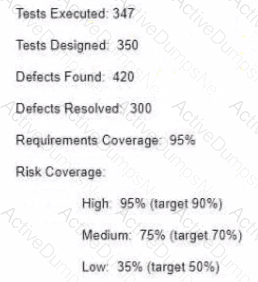
Given this information what is a critical metric you are missing?
It the lest manager must repeatedly step in to resolve conflicts within the team what phase is the team in and what competencies are required from the test manager?
You tend to be conservative in your project estimations because you know how many things can go wrong and extend the schedule. You manager is not happy with your estimates and thinks you are being too negative with your numbers and not trying hard enough Which estimation method should you use to provide your manager with a positive' number while still also providing the number you think is more realistic?
You feel that your team has become lazy when applying good software testing techniques You have given each of them a challenge to take a different business rule and build a full decision tableand then collapse that table You will then assess the results For this assessment, what competencies are you validating?
You are a new lest manager in an organization You have been asked to assess the defect process to determine if there are any efficiency improvements that could be made that would reduce the cost of quality You have started digging through the defect Information What information would be most helpful for this investigation?
There is a debate in your organization about who can close a defect report The developers think they should be able to reject and close defects without any further steps The testers are not happy with this approach as they are afraid the rejections may go undetected and the developers may close something without understanding the real problem
How can this problem be rectified7
In what environment are you most likely to see multiple defect management systems used in one project?
Your defect opened trend is converging to the closed trend but there is still a gap. What does that gap represent?
You have been looking at the actual vs expected defects in one high risk area of the software The actual is much higher than the expected value What should you do?
You have assembled the following cost of quality numbers 1 000 defects were found prior to release and 100 were found after.
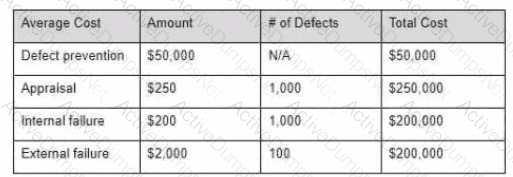
Given this information what should you conclude?
Which of the following Is the common set of information to be produced in a test estimate''
